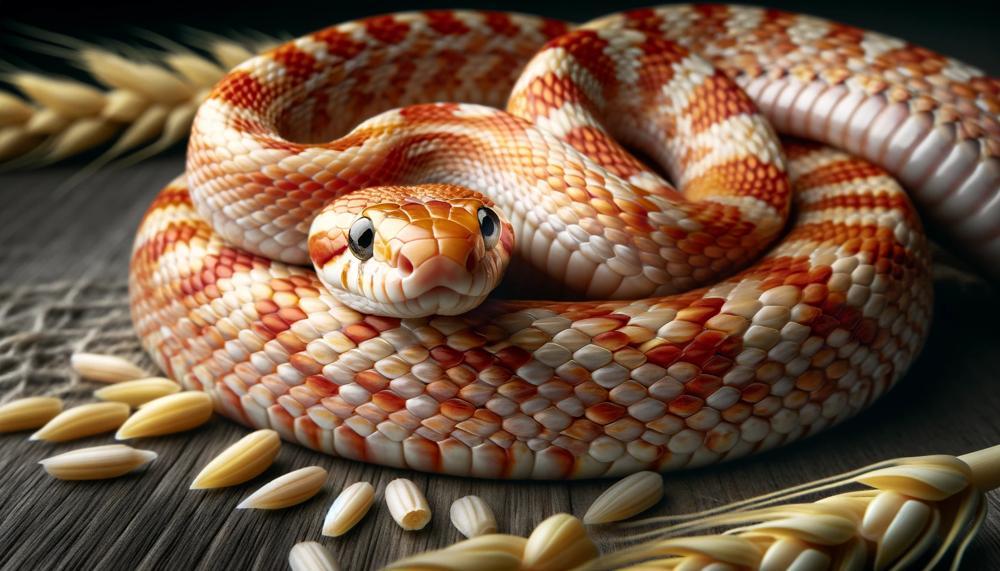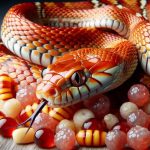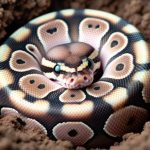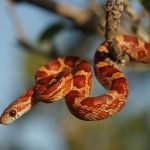Have you ever been mesmerized by the striking colors and gentle demeanor of a corn snake? These popular pets may seem small and harmless, but have you ever wondered just how large they can actually grow?
Prepare to be amazed as we delve into the world of corn snakes and explore the maximum size they can reach.
So, how big can a corn snake get?
Corn snakes can grow to be 24 to 72 inches (61 to 182 centimeters) long and weigh 1 to 3 pounds (454 to 1361 grams). They typically reach their full size between two and three years of age. Female corn snakes are usually larger than males. In the wild, corn snakes usually live around six to eight years, but in captivity can live to an age of 23 years or more.
Curious to know more about these slithery creatures? Let’s take a closer look at each factor that influences their growth. So grab your measuring tape and let’s uncover the secrets behind the maximum size of a corn snake.
Contents
Where do Corn Snakes Live?
Corn snakes are incredibly versatile animals, able to thrive in a range of different environments, which has contributed to their widespread success in the wild. These habitats include fields, forests, farmland, and abandoned buildings, making them one of the most adaptable species of snake.
One of the key physical adaptations that contribute to their success is their slender body and smooth, shiny scales. These features allow them to move quickly and effortlessly through tight spaces or thick vegetation, helping them to evade predators and hunt for prey at night when they are most active. Their excellent eyesight and keen sense of smell also give them an advantage when it comes to hunting.
One particularly unique adaptation of corn snakes is their ability to change color depending on their environment. This remarkable characteristic allows them to blend in with their surroundings, making it easier for them to avoid predators and hunt for food without being detected. In captivity, where selective breeding is more common, these colors may be even more vibrant and varied.
What Do Corn Snakes Look Like?
These snakes have a slender body and can come in various colors, including shades of orange and brownish-yellow. One of the most distinctive features of corn snakes is their large, red blotches outlined in black that run down their backs. Along with that, they have rows of alternating black and white markings on their bellies, giving them a checkerboard pattern.
Their heads are slim with round pupils, and they can grow to be between 6 to 8 centimeters (2 to 3 feet) in length. Additionally, corn snakes have saddle-like markings that run down their bodies to the tip of their tails, with dark borders and varying thicknesses. These markings, along with the pattern on their bellies and head, are key identifiers for different types of corn snakes.
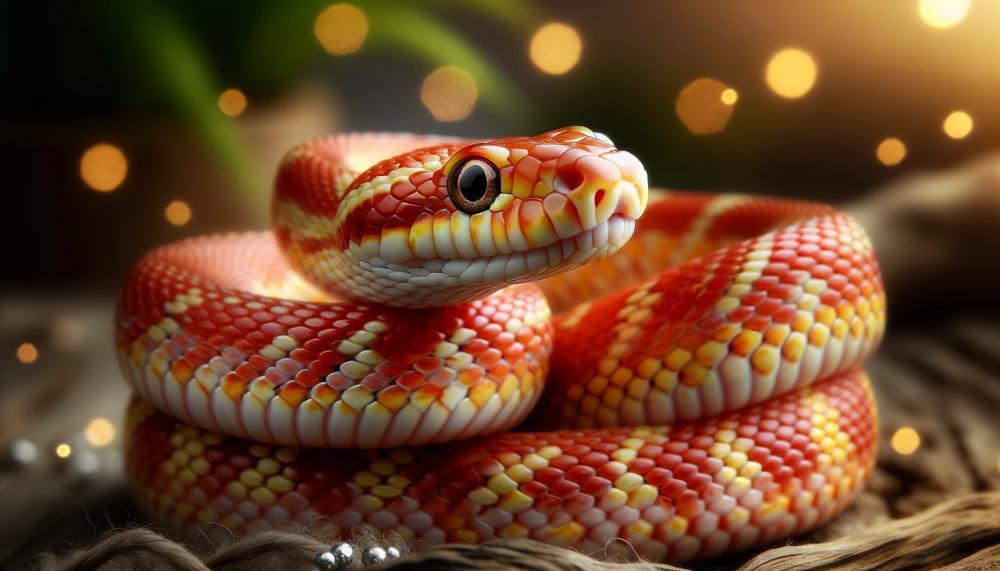
However, what makes corn snakes even more interesting is their ability to change colors. During the shedding process, they can change from shades of pink and orange to gray and white. This color-changing ability adds another layer of uniqueness to these already striking creatures.
Furthermore, corn snakes have a distinctive checkerboard pattern on their bellies, with alternating black and white markings. This pattern, combined with the saddle-like markings on their backs, helps differentiate between different types of corn snakes.
Types
There are currently 45 recognized subspecies of corn snakes, including the Great Plains rat snake, the Red rat snake, and the Black rat snake. However, these three common subspecies are not the only options for pet owners as there are also morphs or color variations within each subspecies that can affect their size.
The Great Plains rat snake, known for its gray, brown, orange, and yellow coloring with black and brown markings, is a popular choice due to its docile nature. On average, they can grow to be 3-4 feet long; however, factors such as diet and environment can play a role in their size. Similarly, the Red rat snake, with its bright red-orange color and black/brown markings, can reach lengths of 4-5 feet and live up to 15-20 years with proper care. The Black rat snake has a striking black color with white/yellow markings and can grow up to 5-6 feet long with a lifespan of 10-15 years.
Aside from these three common subspecies, there are also morphs or color variations that can affect the size of corn snakes. For example, the Amelanistic corn snake is smaller than the wild-type corn snake and has a white/orange coloration.
Factors such as diet, environment, and genetics can also impact the size of corn snakes. Therefore, it is crucial to research the specific subspecies or morph before choosing one as a pet to ensure proper care and handling.
Size
There are various factors that can influence the size of individual corn snakes.
Subspecies and Color Variations:
As mentioned before, there are a total of 45 recognized subspecies of corn snakes, each with unique color and pattern variations. These variations can impact the overall size of the snake, with some subspecies growing larger than others.
For example, the Great Plains corn snake can reach up to 5 feet in length, while the Black rat snake variation usually grows up to 4 feet.
Habitat Size:
The size of a snake’s habitat also plays a crucial role in its growth rate and overall size. Snakes kept in smaller enclosures may not have enough space to fully stretch and move around, hindering their growth potential.
On the other hand, snakes in larger enclosures have more room to move and stretch, promoting healthy growth.
Temperature:
Corn snakes are ectothermic creatures, meaning they rely on external sources to regulate their body temperature. The temperature of their environment directly affects their metabolism and digestion, which can impact their growth rate. Snakes kept in colder environments may have slower metabolisms and growth rates compared to those in warmer environments.
Diet:
Mice are the primary food source for corn snakes, with the frequency and size of their meals directly impacting their growth rate and overall size. Snakes that are consistently fed appropriately sized prey can reach their full potential size.
In contrast, those with irregular feeding habits or given inadequate prey may experience stunted growth.
Diet
A well-balanced and nutritious diet is crucial for maintaining the health and longevity of a corn snake. While they mainly eat meat, corn snakes can consume a wide range of prey items, with rodents being the most common and recommended choice.
However, it is essential to ensure that the size of the prey is suitable for the snake’s size to prevent any potential health complications. Aside from rodents, other potential food sources for corn snakes include small birds, lizards, amphibians, other snakes, and insects.
| Food Type | Description | Potential Benefits/Concerns |
| Rodents | Usually mice or rats, depending on the snake’s size | Provides necessary nutrients and protein for growth and overall health; must ensure appropriate size to avoid choking or digestive issues |
| Small Birds | Prey items such as chicks or quail may be offered as a supplement to a rodent-based diet | Can add variety and nutritional value to the diet; may be more challenging to obtain compared to other food sources |
| Lizards/Amphibians | Includes small geckos, frogs, or salamanders | Can provide a natural food source for wild-caught snakes; may carry parasites or diseases if not properly sourced and prepared |
| Other Snakes | May include smaller species such as garter snakes or ringneck snakes | Can provide a natural food source for wild-caught snakes; may carry parasites or diseases if not properly sourced and prepared |
| Insects | Can consist of crickets, mealworms, or waxworms | High in protein and can be used as a supplement to other food sources; may not provide enough nutrients on its own |
It is worth noting that the diet of a corn snake can vary depending on their size, age, and individual preferences. It is advisable to seek guidance from a veterinarian or reptile expert to determine the appropriate diet for your specific corn snake.
Additionally, it is crucial to ensure that all prey items are sourced and prepared correctly to avoid any potential health risks for your snake.
Size Comparison: Corn Snake vs. Human
Corn snakes and humans may both be living creatures, but their size and characteristics greatly differ. While corn snakes can reach up to 5 feet in length, the average adult human stands at approximately 5.7 feet tall.
This means that a corn snake is typically about one-third the size of a human.
| Corn Snake | Human | |
| Average Length | 4-5 feet | 5.7 feet |
| Average Weight | 900 grams (2 lbs) | 62 kg (136 lbs) |
| Habitat | Cornfields and captivity | N/A (varies) |
| Diet | Mice and occasional small rodents | Varies, but typically includes a mix of fruits, vegetables, and meats. |
| Venomous? | No | No |
| Threat to Humans? | No | No (varies depending on the situation) |
As shown in the table above, there are significant differences between corn snakes and humans in terms of size, weight, habitat, diet, and potential threat level.
While people may vary in size and weight, corn snakes have a slow and steady growth rate that takes 2-3 years to reach its full potential length.
Size Comparison: Corn Snake vs. Garden Hose
When it comes to size, a fully grown Corn Snake can reach up to 5-6 feet in length, making them one of the larger pet snakes. This is significantly longer than a standard garden hose, which typically measures around 50 feet.
However, it should be noted that the diameter of a garden hose is much larger than that of a Corn Snake, with an average diameter of ¾ inch compared to the snake’s diameter of approximately 2 inches.
The growth rate of a Corn Snake is relatively slow, taking 2-3 years to reach adulthood. In comparison, their lifespan in captivity is longer than in the wild. It is also worth mentioning that female snakes are usually larger than males, although overall size can also be influenced by factors such as genetic makeup and environmental conditions.
To better visualize the size comparison between a Corn Snake and a garden hose, the following table shows the average length and weight of Corn Snakes at different stages of their growth:
| Age (years) | Length (inches) | Weight (grams) |
| 0-1 | 7-10 | 20-30 |
| 1-2 | 16-24 | 50-100 |
| 2-3 | 24-36 | 100-200 |
| 3+ | 36+ | 200+ |
As evident from the table, Corn Snakes experience significant growth during their first year, with their length and weight almost doubling by the time they reach adulthood.
Size Comparison: Corn Snake vs. Ball Python
When it comes to size, the Ball Python is typically larger than the Corn Snake, with an average length of 6 feet for Ball Pythons and 3-5 feet for Corn Snakes. These differences in size are important to keep in mind when deciding which species to have as a pet, as they can impact things like housing needs and expenses.
To better understand the size comparison between these two popular snake species, let’s take a closer look at their individual characteristics and requirements.
Terrarium Size:
The Ball Python prefers larger enclosures, while the Corn Snake does well in smaller spaces. This is due to their natural habitats, with Ball Pythons coming from Africa where they have more space to roam, and Corn Snakes being native to the Southeastern United States where they tend to live in smaller areas.
As a result, the cost of housing may also differ between the two species.
Temperament:
Both the Ball Python and Corn Snake have similar temperaments, making them suitable options for pet owners. They are docile and easy to care for, but it is important to avoid handling them immediately after they have eaten.
However, it should be noted that snakes are wild animals and may behave differently in captivity, so caution should always be exercised when handling them.
Diet:
Both the Ball Python and Corn Snake are carnivorous and require a diet of frozen-thawed mice or rats. It is crucial to feed them appropriately sized prey based on their size and to avoid handling them until they have fully digested their food.
Lifespan:
Ball Pythons can live for up to 40 years, while Corn Snakes have a shorter lifespan of around 20 years.
This is an essential factor to consider when choosing a pet snake, as it is a long-term commitment.
Conclusion
In conclusion, the corn snake is a fascinating creature that can reach impressive sizes. While their average length falls between 3-5 feet, some individuals have been known to grow up to 6 feet long. The size of a corn snake is influenced by genetics, diet, and environmental conditions. Interestingly, female corn snakes tend to be larger than males, and a well-fed and healthy snake will reach its maximum size faster than one that is undernourished.
These slithery creatures are highly adaptable and can thrive in various environments due to their unique physical characteristics and behaviors. Their ability to change color based on their surroundings adds to their distinctiveness and helps them evade predators.
With 45 recognized subspecies and countless color variations within each subspecies, the diversity among corn snakes is boundless. Proper care and handling are crucial in helping these snakes reach their full potential size and live long, healthy lives. A well-balanced diet consisting primarily of rodents is essential for maintaining the overall health and longevity of a corn snake.

